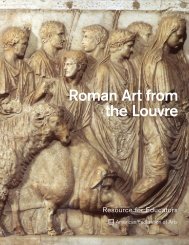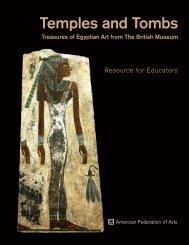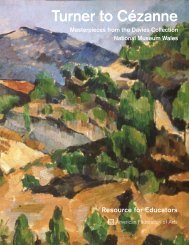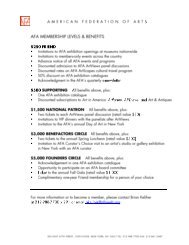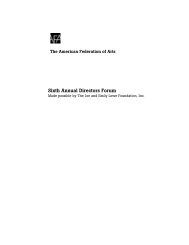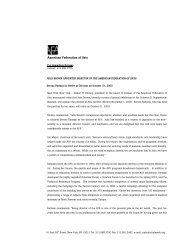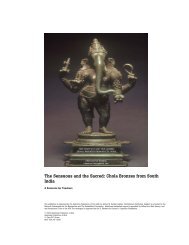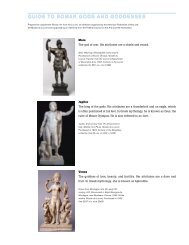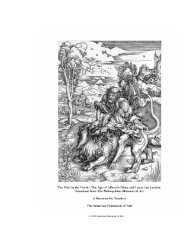Rubens, Jordaens, Van Dyck and their Circle: Flemish Master ...
Rubens, Jordaens, Van Dyck and their Circle: Flemish Master ...
Rubens, Jordaens, Van Dyck and their Circle: Flemish Master ...
You also want an ePaper? Increase the reach of your titles
YUMPU automatically turns print PDFs into web optimized ePapers that Google loves.
The exhibition is organized by the American Federation of Arts <strong>and</strong> the Museum Boijmans <strong>Van</strong> Beuningen.<br />
Support has been provided by the Government of Fl<strong>and</strong>ers. Additional support has been provided by the<br />
Eugene V. <strong>and</strong> Clare E. Thaw Charitable Trust.<br />
@20002 American Federation of Arts
<strong>Rubens</strong>, <strong>Jordaens</strong>, <strong>Van</strong> <strong>Dyck</strong> <strong>and</strong> Their <strong>Circle</strong>: <strong>Flemish</strong> <strong>Master</strong><br />
Drawings from the Museum Boijmans <strong>Van</strong> Beuningen<br />
Contents<br />
• About This Resource 1<br />
• Exhibition Overview 1–3<br />
• Selected Works of Art from the Exhibition 4<br />
Peter Paul <strong>Rubens</strong> : Profile of a Young Man 4-5<br />
Young Woman with Folded H<strong>and</strong>s 6<br />
Jacobs <strong>Jordaens</strong>: The Continence of Scipio 7-8<br />
Parrot 9-10<br />
Anthony van <strong>Dyck</strong>: Seated Man, Leaning Backwards 11-12<br />
Pieter Bout: Fisherman Selling <strong>their</strong> Catch on the Beach 13<br />
Abraham van Diepenbeeck: Decorative Border 14-15<br />
Frans Snijders: Sheet of Studies of a Donkey, Two Foxes <strong>and</strong> a Dog 16-17<br />
Lucas van Uden: L<strong>and</strong>scape with a Church in the Foreground 18-19<br />
Jan Wildens: The Month of March 20<br />
• Glossary of Drawing Terms 21-23<br />
• Select Bibliography <strong>and</strong> Web Resources 24<br />
• Further Reading 24<br />
The Exhibition Overview <strong>and</strong> Information on Works of Art are adapted from the didactic labels in the<br />
exhibition which were written by guest curator A.W.F.M. Meij, Chief Curator of the Museum Boijmans <strong>Van</strong><br />
Beuningen. The Discussion Questions <strong>and</strong> Activities were written by Nelly Silagy Benedek, Director of<br />
Education at the American Federation of Arts. The Glossary of Drawing Terms was prepared by Nelly Silagy<br />
Benedek with the assistance of Megan Porcaro.<br />
If you have any questions about this educator’s resource contact:<br />
Nelly Silagy Benedek, Director of Education<br />
American Federation of Arts<br />
41 East 65 th Street, New York, NY 10021.<br />
Telephone: 212 988 7700 x26<br />
Fax: 212 861 2487<br />
Email: nbenedek@afaweb.org<br />
ii
About This Resource<br />
Works of art can be a great source of inspiration for elementary, middle school <strong>and</strong> high<br />
school students. The aim of this resource is to help teachers teach students how to<br />
approach works of art using critical thinking skills. Teachers may use these materials in<br />
conjunction with a class visit to the museum or independently. Suggested activities <strong>and</strong><br />
discussion questions focus on individual works of art <strong>and</strong> offer ways of making these<br />
works of art accessible to students.<br />
The writing projects <strong>and</strong> drawing exercises in this packet are adaptable to<br />
different age levels <strong>and</strong> may be used as points of departure for lesson plans. For the<br />
drawing projects, encourage your students to focus more on communicating an idea <strong>and</strong><br />
experimenting with forms than with rendering accurate perspective <strong>and</strong> correct<br />
proportions. Have older studio art students think about rendering three-dimensional form<br />
by using cross-hatching <strong>and</strong> other drawing techniques they observe in the works of art.<br />
The objectives of the discussion topics <strong>and</strong> classroom activities are manifold.<br />
They are a first step in engaging students in the process of looking at <strong>and</strong> analyzing works<br />
of art. Furthermore, they create links with topics <strong>and</strong> concepts students are studying in<br />
school. Finally <strong>and</strong> most important, they are designed to encourage students to have<br />
meaningful relationships with the works of art <strong>and</strong> to explore <strong>and</strong> give expression to the<br />
thoughts, ideas, <strong>and</strong> experiences that are a part of <strong>their</strong> lives.<br />
Exhibition Overview<br />
Dutch museums are not typically major collectors of seventeenth-century <strong>Flemish</strong> art.<br />
Political <strong>and</strong> religious differences between the northern <strong>and</strong> southern Netherl<strong>and</strong>s at the<br />
beginning of the seventeenth century <strong>and</strong>, later, the popularity of Rembr<strong>and</strong>t in the<br />
northern Netherl<strong>and</strong>s, contributed to the lack of interest in collecting <strong>Flemish</strong> art. The<br />
Museum Boijmans <strong>Van</strong> Beuningen is an exception <strong>and</strong> has one of the premier collections<br />
of drawings in the world <strong>and</strong> a rich selection of seventeenth-century <strong>Flemish</strong> art.<br />
Extensive holdings of <strong>Flemish</strong> drawings were built primarily through large gifts from two<br />
extraordinary collectors for whom the museum is named. In 1849 F.J.O. Boijmans<br />
bequeathed to the museum almost two hundred master drawings, <strong>and</strong> almost a century<br />
later, in 1941, D.G. van Beuningen donated one hundred sheets originally belonging to<br />
Franz Koenigs, a leading Dutch collector.<br />
Seventeenth-century Fl<strong>and</strong>ers encompassed parts of present day France,<br />
Belgium, <strong>and</strong> the Netherl<strong>and</strong>s. This exhibition includes the work of artists who were<br />
active in <strong>and</strong> around Fl<strong>and</strong>ers <strong>and</strong> presents a selection of the museum’s finest <strong>Flemish</strong><br />
drawings, including a large number of works by the most celebrated artists of the<br />
seventeenth century: Peter Paul <strong>Rubens</strong> (1577–1640), Jacob <strong>Jordaens</strong> (1593–1678), <strong>and</strong><br />
Anthony van <strong>Dyck</strong> (1599–1641). Also featured are exquisite drawings by contemporaries<br />
of these three great masters who excelled in <strong>their</strong> respective genres <strong>and</strong> were highly<br />
respected in <strong>their</strong> day.<br />
The works in this comprehensive selection reveal the varied role of drawings—as<br />
preliminary studies, detailed sketches, copies of earlier works of art, designs used as<br />
prototypes for prints, <strong>and</strong> quick sketches—<strong>and</strong> the wealth of styles <strong>and</strong> techniques<br />
characteristic of the Golden Age of <strong>Flemish</strong> art.<br />
Peter Paul <strong>Rubens</strong><br />
Siegen 1577–1640 Antwerp<br />
Humanist, diplomat, scholar, <strong>and</strong> artistic genius, Peter Paul <strong>Rubens</strong> is one of the foremost<br />
<strong>Flemish</strong> artists. Born in the German town of Siegen, <strong>Rubens</strong> moved to Antwerp when he<br />
was still quite young. In 1600 he, like many young artists of his time, traveled to Italy to<br />
study <strong>and</strong> copy Italian art <strong>and</strong> the classical treasures then being excavated. In particular,<br />
<strong>Rubens</strong> studied works of art by the two Renaissance masters Michelangelo (1475–1564)<br />
<strong>and</strong> Raphael (1483–1520) <strong>and</strong> was also deeply impressed by the works of Annibale<br />
Carracci (1560–1609) <strong>and</strong> Caravaggio (1573–1610), notably the latter’s dramatic use of<br />
chiaroscuro. Upon his return to Antwerp in 1608, <strong>Rubens</strong> introduced the color <strong>and</strong> line<br />
he had absorbed in Italy into his painting <strong>and</strong> soon became one of the most sought-after<br />
<strong>and</strong> respected artists in Europe.<br />
1
Between 1617 <strong>and</strong> 1620 <strong>Rubens</strong> taught the young painter Anthony van <strong>Dyck</strong>,<br />
with whom he also collaborated on many projects. At the age of fifty-three, <strong>Rubens</strong>, a<br />
widower, married Hélène Fourment, a sixteen-year-old merchant’s daughter, who often<br />
acted as his model. The drawings that <strong>Rubens</strong> made of Fourment in the last decade of<br />
his life are among his most masterful <strong>and</strong> moving.<br />
<strong>Rubens</strong>’s classical education combined with his brilliance as an artist resulted in<br />
powerful allegorical <strong>and</strong> historical paintings <strong>and</strong> exquisite drawings he created in<br />
preparation for them. He was the main proponent of the Baroque style in the southern<br />
Netherl<strong>and</strong>s, introducing unusual vantage points, dynamic forms—at times sculptural at<br />
other times painterly—<strong>and</strong> sensual <strong>and</strong> luminous color into his paintings. A master<br />
colorist <strong>and</strong> draftsman, <strong>Rubens</strong> was versatile, prolific, <strong>and</strong> capable of conveying high<br />
drama <strong>and</strong> emotion. He executed paintings, designed tapestries, participated in the<br />
design <strong>and</strong> decoration of architectural projects, <strong>and</strong> made countless numbers of<br />
preparatory drawings that were used as studies for his work. <strong>Rubens</strong>’s great prestige <strong>and</strong><br />
popularity resulted in commissions from several royal courts <strong>and</strong> noble families. As was<br />
customary at the time, the artist employed many exceptional draftsmen, painters, <strong>and</strong><br />
engravers in his studio who collaborated with him on the execution of his works <strong>and</strong><br />
facilitated <strong>their</strong> wide dissemination.<br />
<strong>Rubens</strong>’s success resulted in great financial rewards. His interest in art <strong>and</strong> his<br />
staggering wealth led him to assemble a large art collection of paintings, sculptures, <strong>and</strong><br />
drawings. In addition, <strong>Rubens</strong> retained many of his own works of art to which he<br />
frequently referred for ideas.<br />
The large number of drawings by <strong>Rubens</strong> presented here provides a rare<br />
opportunity to see the range <strong>and</strong> virtuosity of his drawings which even in his day<br />
established his reputation as a master draftsman. The other twenty artists featured in this<br />
exhibition were all in <strong>Rubens</strong>’s circle, <strong>and</strong> were profoundly affected by his work. Many,<br />
such as <strong>Van</strong> <strong>Dyck</strong> <strong>and</strong> Frans Snijders (1579–1657), worked at various times alongside<br />
him; some, like Abraham van Diepenbeeck (1596–1675), were his pupils, while others,<br />
such as Lucas Vorsterman (1595–1675) <strong>and</strong> Paulus Pontius (1596–1658), were engravers<br />
in his studio. Universally acclaimed, <strong>Rubens</strong> inspired artists in France, Spain, Engl<strong>and</strong>,<br />
<strong>and</strong> even Russia. His impact on the course of European art, evidenced by a prodigious<br />
oeuvre <strong>and</strong> the widespread emulation of his style, was felt for generations to come.<br />
Jacob <strong>Jordaens</strong><br />
Antwerp 1593–1678 Antwerp<br />
Jacob <strong>Jordaens</strong> was born in Antwerp <strong>and</strong> at the age of fourteen was apprenticed to Adam<br />
van Noort, who had also been <strong>Rubens</strong>’s teacher. <strong>Van</strong> Noort was a great influence in<br />
<strong>Jordaens</strong>’s life: he was not only his tutor, but his father-in-law <strong>and</strong> a close friend. By<br />
1615, when <strong>Jordaens</strong> was twenty-two, he was registered as a master painter in the Guild<br />
of Saint Luke, <strong>and</strong> by the 1620s had formed his own workshop.<br />
<strong>Jordaens</strong>’s early drawing style, although heavily indebted to <strong>Rubens</strong>, whom he<br />
assisted on many projects, was less idealistic than that of either <strong>Rubens</strong> or <strong>Van</strong> <strong>Dyck</strong>. His<br />
depictions of biblical, mythological, <strong>and</strong> allegorical subjects exhibit the verisimilitude of<br />
figures observed from life. Jordaen’s drawings also reflect the influence of Italian masters<br />
such as Caravaggio <strong>and</strong> Titian (ca. 1485–1576), most notably in the strong contrasts<br />
between light <strong>and</strong> shadow <strong>and</strong> the characteristic renderings of figures in red, black, <strong>and</strong><br />
white chalk. <strong>Jordaens</strong> studied these Italian artists through his mentor, <strong>Rubens</strong>, whose<br />
collection included works by the artists <strong>and</strong> whose own art skillfully incorporated stylistic<br />
characteristics of Italian painting.<br />
Upon the deaths of <strong>Rubens</strong> <strong>and</strong> <strong>Van</strong> <strong>Dyck</strong> in 1640 <strong>and</strong> 1641, respectively,<br />
<strong>Jordaens</strong> became the most important painter in the southern Netherl<strong>and</strong>s; during his most<br />
fruitful period, from 1640 to 1645, he—like the two artists before him—secured many<br />
commissions from all over Europe. It was during this period that he also began to<br />
undertake the large dramatic drawings <strong>and</strong> paintings for which he is best known. In the<br />
last decades of his life, <strong>Jordaens</strong> found inspiration in his own earlier drawings, either<br />
reworking them or combining elements into new work.<br />
2
Anthony van <strong>Dyck</strong><br />
Antwerp 1599–1641 London<br />
Best known for his elegant <strong>and</strong> brilliantly crafted portraits, Anthony van <strong>Dyck</strong> is<br />
considered one of the most important artists of the seventeenth century. In his teens, <strong>Van</strong><br />
<strong>Dyck</strong> was active in <strong>Rubens</strong>’s workshop, first as his pupil, then as his assistant, <strong>and</strong> soon<br />
absorbed <strong>Rubens</strong>’s style <strong>and</strong> technique. Not surprisingly, <strong>Van</strong> <strong>Dyck</strong>’s work of this period<br />
shares much in common with his teacher’s. Many of his early paintings, for example, are<br />
based on <strong>Rubens</strong>’s compositions <strong>and</strong> <strong>Van</strong> <strong>Dyck</strong> also emulated <strong>Rubens</strong>’s practice of<br />
employing live models for his drawings. As striking as the similarities are between the<br />
two artists, the differences, especially in the nude studies, are equally distinct: <strong>Rubens</strong>,<br />
more interested in rendering anatomical detail, placed great emphasis on the musculature<br />
of the body, while <strong>Van</strong> <strong>Dyck</strong> concentrated more on its contours.<br />
In 1621 <strong>Van</strong> <strong>Dyck</strong> left for Italy, where he would spend the next six years, <strong>and</strong><br />
where he began making quick sketches. He did not share <strong>Rubens</strong>’s interest in classical<br />
art; instead, he was drawn to the Venetian painters of the sixteenth century, especially<br />
Titian. In fact, Titian’s name appears on several pages of <strong>Van</strong> <strong>Dyck</strong>’s sketchbook next to<br />
drawings after the Italian artist’s paintings. <strong>Van</strong> <strong>Dyck</strong>’s passion for Venetian art extended<br />
to collecting <strong>and</strong> as did <strong>Rubens</strong>, he built a substantial art collection witnessed by an<br />
inventory of <strong>Van</strong> <strong>Dyck</strong>’s possessions that listed nineteen works by Titian, an astonishing<br />
number by the great Venetian master, <strong>and</strong> dramatic evidence of <strong>Van</strong> <strong>Dyck</strong>’s financial<br />
success. Upon his return to Antwerp, <strong>Van</strong> <strong>Dyck</strong> supervised a large studio, fulfilling many<br />
commissions for portraits <strong>and</strong> altarpieces.<br />
The drawings in this exhibition offer an exciting glimpse into <strong>Van</strong> <strong>Dyck</strong>’s artistic<br />
process. His studies for portraits <strong>and</strong> religious paintings are masterful examples of<br />
draftsmanship, the grace <strong>and</strong> strength of the artist’s line as captivating in these works as<br />
in his greatest paintings.<br />
In 1632, <strong>Van</strong> <strong>Dyck</strong> settled permanently in London, where he gained renown as<br />
court painter to King Charles I. Like <strong>Rubens</strong>, <strong>Van</strong> <strong>Dyck</strong>’s influence was felt throughout<br />
Europe <strong>and</strong> Great Britain. Many artists made copies <strong>and</strong> prints based on <strong>Van</strong> <strong>Dyck</strong>’s<br />
paintings. Attesting to his widespread influence, The Iconography of <strong>Van</strong> <strong>Dyck</strong>, a<br />
collection of more than one hundred prints by various engravers based on portraits by <strong>Van</strong><br />
<strong>Dyck</strong>, was published posthumously in 1645.<br />
3
Selected Works of Art from the Exhibition<br />
Peter Paul <strong>Rubens</strong><br />
Profile of a Young Man with a Hairb<strong>and</strong><br />
Peter Paul Ruben (Siegen 1577-1640 Antwerp)<br />
Profile of a Young Man with Hairb<strong>and</strong><br />
Brush <strong>and</strong> brown <strong>and</strong> gray wash over metalpoint<br />
on gray-blue prepared paper<br />
8 5/8 x 5 3/8 in (22 x 13.7 cm)<br />
<strong>Rubens</strong> had an extensive art collection that included his own art, as well as works by<br />
other artists. Among these were about two hundred <strong>and</strong> forty that he retouched.<br />
Originally a drawing in metalpoint attributed to the Milanese artist Ambrogio de’ Predis<br />
(second half of the sixteenth century) who worked in the style of Leonardo da Vinci<br />
(1452–1519), this drawing, which was in <strong>Rubens</strong>’s collection, is almost unrecognizable<br />
because of the <strong>Flemish</strong> master's extensive retouching. <strong>Rubens</strong> augmented the young<br />
man’s eyes <strong>and</strong> upper lip with pen <strong>and</strong> brown ink <strong>and</strong> used a brush <strong>and</strong> brown ink to add<br />
details like the flowing hair <strong>and</strong> hairb<strong>and</strong>. The original lines of metalpoint are now visible<br />
only in the man’s face <strong>and</strong> outside the frame drawn by <strong>Rubens</strong> with a brush.<br />
Discussion Questions<br />
• Do you collect anything If so, what do you do with the objects you collect Do you<br />
preserve them the way they are or do you alter them in some way<br />
• Discuss <strong>Rubens</strong>’s practice of reworking drawings by other artists. Why would he do<br />
this Why might one argue against doing this<br />
• Discuss the ways in which <strong>Rubens</strong>’s retouching created an entirely new work of art.<br />
Activity: Making an Image Your Own<br />
Aim: To find an image that captures the student’s interest <strong>and</strong> alter it in a significant way.<br />
Materials: magazines, paper, scissors, glue <strong>and</strong> either, pencils, crayons, paint <strong>and</strong><br />
paintbrushes<br />
Procedure:<br />
• Ask your students to bring in old magazines from home.<br />
4
• Have them look through the magazines <strong>and</strong> choose a single image that they find<br />
compelling.<br />
• Have students cut out the picture <strong>and</strong> paste it onto a large sheet of paper.<br />
• Ask students to alter the image in a way that makes them feel they have created <strong>their</strong><br />
own work of art.<br />
• Students may use pencil, crayons, or any other medium they choose. They may even<br />
decide to combine a number of smaller photographs cut from the magazines <strong>and</strong><br />
create a collage with the original image as the focal point.<br />
• Display students’ work for a class discussion. Discuss how each original image has<br />
changed in appearance <strong>and</strong> how its visual impact is different.<br />
5
Peter Paul <strong>Rubens</strong><br />
Young Woman with Folded H<strong>and</strong>s<br />
Peter Paul <strong>Rubens</strong> (Siegen 1577-1640 Antwerp)<br />
Young Woman with Folded H<strong>and</strong>s<br />
Red <strong>and</strong> black chalk heightened with white<br />
18 5/5 x 14 in (47.3 x 35.4 cm)<br />
<strong>Rubens</strong> <strong>and</strong> other artists of his day often executed studies of individual figures that they<br />
later incorporated into larger drawings or paintings. This study of an unidentified woman<br />
was among the artist’s favorites. He used this portrait as the basis for a number of<br />
paintings he produced in the first half of the 1630s.<br />
Discussion Questions<br />
• Ask your students to look at <strong>and</strong> describe <strong>Rubens</strong>’s drawing. How has <strong>Rubens</strong><br />
portrayed this woman What has he communicated to the viewer about her or<br />
about his impression of her Which parts of her figure seem most important in<br />
the drawing<br />
• Into what sort of larger work do you imagine the artist might incorporate her<br />
Activity: Integrating a Figure Study into a Larger Composition<br />
Aim: To create a figure study <strong>and</strong> incorporate it into a larger composition.<br />
Materials: paper, chalk, pencil (optional: paint, paintbrushes, pastels)<br />
Procedure:<br />
• Have your students choose one of <strong>their</strong> classmates or a family member as the<br />
subject of a drawing.<br />
• Before they begin <strong>their</strong> drawings have your students think about the pose <strong>and</strong><br />
facial expression of <strong>their</strong> figure. What sort of mood or character do they want to<br />
convey<br />
• After they have finished <strong>their</strong> figure study have your students take another sheet<br />
of paper <strong>and</strong> create a larger scene that incorporates <strong>their</strong> original drawing. They<br />
may create a narrative, a group portrait, or a genre or everyday scene. Students<br />
may want to dress the figure as a recognizable character from a historical or<br />
fictional narrative. For the second drawing, they may want to use other media<br />
such as pastels or paint.<br />
• How is the original figure different in the context of the larger setting<br />
6
Jacob <strong>Jordaens</strong><br />
The Continence of Scipio<br />
Jacob <strong>Jordaens</strong> (1593-1678 Antwerp)<br />
The Continence of Scipio<br />
Brush <strong>and</strong> brown ink, brown ink <strong>and</strong> bodycolor<br />
8 5/8 x 9 ½ in (22x24.2 cm)<br />
Brush <strong>and</strong> brown ink, brown wash, bodycolor on paper, red chalk in the face of the man<br />
at the far left; strip of paper added to the left edge by <strong>Jordaens</strong>; laid down<br />
In this drawing, believed to be based on a 1622 painting by <strong>Rubens</strong>, <strong>Jordaens</strong> represents<br />
an episode in a campaign of the Roman general Publius Cornelius Scipio Africanus Maior.<br />
Scipio conquered the city of Carthage, a long-established enemy of Rome in 209 B.C., <strong>and</strong><br />
proved a magnanimous conqueror to his prisoners <strong>and</strong> hostages, including Prince Allucius<br />
<strong>and</strong> his bride. After the bride’s parents paid the ransom dem<strong>and</strong>ed for <strong>their</strong> daughter <strong>and</strong><br />
her future husb<strong>and</strong>, Scipio set them free <strong>and</strong> returned the ransom to the couple as a<br />
wedding present.<br />
This story, which illustrates aristocratic generosity, was an extremely popular<br />
subject in seventeenth-century art. <strong>Jordaens</strong> depicts Scipio seated on a throne <strong>and</strong><br />
flanked by warriors. Before the general kneel the prince <strong>and</strong> his bride, together with a<br />
number of other figures. The valuables that were to serve as a ransom lie at the feet of<br />
Scipio, who makes a dismissive gesture to the figure behind the bride (perhaps one of her<br />
parents).<br />
Discussion Questions<br />
• Have students look at the drawing <strong>and</strong> describe what they see. Ask them to describe<br />
the expressions of the figures’ faces. What do they think is going on<br />
• How has <strong>Jordaens</strong> arranged the figures in his drawing Describe this arrangement or<br />
composition.<br />
• Which is the figure of Scipio What has the artist done to make him seem important<br />
What colors has <strong>Jordaens</strong> used in this work How has he used color to balance his<br />
composition<br />
• Notice the strip of paper <strong>Jordaens</strong> has added to the left side. How does this added<br />
segment contribute to the overall drawing in terms of composition <strong>and</strong> content<br />
7
Activity: Drawing a Scene from a Narrative<br />
Aim: To draw a dramatic moment from a historical or fictional narrative.<br />
Materials: paper <strong>and</strong> pencil<br />
Procedure:<br />
• Choose a historical narrative with which your students are familiar or a fictional work<br />
that your students have read as the subject of students’ drawings. This activity may<br />
be related to a topic you are studying in class.<br />
• Ask students to write a synopsis of the narrative.<br />
• Ask them to pinpoint one of the most dramatic scenes in the narrative.<br />
• Have students make a drawing of the scene they have chosen. Ask them to focus less<br />
on rendering details <strong>and</strong> more on considering the overall composition of <strong>their</strong><br />
respective drawings.<br />
8
Attributed to Jacob <strong>Jordaens</strong><br />
A Parrot<br />
Jacob <strong>Jordaens</strong> (1593-1678 Antwerp)<br />
A Parrot<br />
Colored chalk<br />
7 3/8 x 5 ¾ in. (32.4 x 22.6 cm)<br />
During the seventeenth century, the wealthy <strong>and</strong> privileged collected various<br />
species of birds for aesthetic <strong>and</strong> scientific purposes. Exotic species such as the<br />
parrot depicted here were especially prized. Birds also represented the glory <strong>and</strong><br />
diversity of God’s creation. This parrot, most likely created for a larger work, can<br />
be found in paintings by <strong>Rubens</strong> <strong>and</strong> Snijders as well as in a drawing by<br />
Snijders.<br />
Discussion Question<br />
• Discuss how artists made studies of birds <strong>and</strong> animals that they later<br />
incorporated into larger works. In other words, discuss how artists would create<br />
drawings of birds or animals as a way of studying them before including them in<br />
a large painting.<br />
Activity: Creating a Setting for a Bird or Animal Study<br />
Aim: To draw a picture of a bird or animal <strong>and</strong> incorporate it into a larger setting or to<br />
integrate a reproduction of the parrot attributed to <strong>Jordaens</strong> into a larger drawing created<br />
by the student.<br />
Materials: paper, pencils, chalk, colored pencils, any other drawing media<br />
Procedure:<br />
• Have students look at the drawings of animals/birds included in this resource.<br />
• Ask students how they would integrate either the drawing of the parrot or<br />
another bird or animal into a larger composition.<br />
• Ask students to create <strong>their</strong> own studies of a bird or animal <strong>and</strong> then incorporate<br />
it into a larger work, or cut out the parrot from the color copy included in this<br />
9
esource, paste it onto a large sheet of paper, <strong>and</strong> draw or paint a setting around<br />
it.<br />
Activity: Collaborative Drawing Project<br />
Aim: To work collaboratively on a single drawing or painting as did many of the artists in<br />
the exhibition.<br />
Materials: paper, pencils, paint <strong>and</strong> paintbrushes<br />
Procedure:<br />
• Divide your students into small groups.<br />
• One student might paint the animal or bird, another the l<strong>and</strong>scape, <strong>and</strong> a third,<br />
the figures.<br />
• Have each group discuss ideas for the work of art <strong>and</strong> make decisions about the<br />
subject matter <strong>and</strong> composition of the work before they begin.<br />
10
Anthony van <strong>Dyck</strong><br />
Seated Man, Leaning Backwards<br />
Anthony van <strong>Dyck</strong> (Antwerp 1599-1641 London)<br />
Seated Man, Leaning Backwards<br />
Black chalk heightened with white, laid down on white woven paper<br />
9 ¼ x 10 7/8 in (23.6 x 27.5 cm)<br />
<strong>Van</strong> <strong>Dyck</strong>’s emulation of <strong>Rubens</strong> is exemplified in this drawing. Like <strong>Rubens</strong>, <strong>Van</strong><br />
<strong>Dyck</strong> used black chalk heightened with white <strong>and</strong> sketched his models from life.<br />
In order to maintain this difficult pose for an extended period of time, the model<br />
pictured in this drawing had to support himself by holding a rope, apparent in<br />
<strong>Van</strong> <strong>Dyck</strong>’s positioning of the h<strong>and</strong>s.<br />
Discussion Questions<br />
• Have your students study <strong>Van</strong> <strong>Dyck</strong>’s drawing.<br />
• What do they think of the drawing Why<br />
• Why do they think <strong>Van</strong> <strong>Dyck</strong> focused on the man’s back<br />
• Discuss the artist’s interest in capturing an active pose <strong>and</strong> the challenge of<br />
rendering such as pose.<br />
• Discuss the process of creating a work of art, in particular the many stages of<br />
preparation that an artist goes through when working on a major project. Ask<br />
students what they think is involved in this sort of process. Emphasize the<br />
importance of studies <strong>and</strong> preparatory drawings.<br />
• Discuss how <strong>and</strong> why <strong>Van</strong> <strong>Dyck</strong> <strong>and</strong> other artists drew from live models. Note<br />
how the artist used this particular drawing as a component of other works <strong>and</strong><br />
how other seventeenth-century artists created similar images.<br />
Activity: Contour Drawings<br />
Aim: To choose an expressive pose or stance as a subject <strong>and</strong> create a drawing focusing<br />
on the contour of the body that conveys the action or pose.<br />
Materials: paper <strong>and</strong> pencil, charcoal or chalk<br />
Procedure:<br />
• Have students choose an expressive pose or stance as the subject of a drawing.<br />
The subject may be a person walking, sitting, stretching, or engaging in another<br />
11
activity. Older students may work from a live model. Younger students may use<br />
<strong>their</strong> imagination or look at photographs in magazines for ideas.<br />
• Using pencil, charcoal, or chalk, have students make a drawing that focuses on<br />
the shape or outline of the body rather than on anatomical details. Emphasize<br />
that this is an exercise; students should concentrate more on the process of<br />
looking <strong>and</strong> drawing than on the final product.<br />
• When they have finished, discuss the challenges students may have experienced<br />
during this process.<br />
12
Pieter Bout<br />
Fishermen Selling Their Catch on the Beach<br />
Peter Bout (1658-1719 Brussels)<br />
Fishermen Selling <strong>their</strong> Catch on the Beach<br />
Brush <strong>and</strong> dark gray ink, gray wash, laid down<br />
7/8 x 10 ¼ in. (20 x 26 cm).<br />
This sheet depicts a group of fishermen <strong>and</strong> <strong>their</strong> wives on a beach collecting<br />
freshly caught fish. Details such as the dog on the right <strong>and</strong> the two figures<br />
resting on the left contribute to the realism of this genre scene or scene of<br />
everyday life. Bout has rendered the figures <strong>and</strong> boats on the beach in great<br />
detail <strong>and</strong> employed rich washes to articulate the sky <strong>and</strong> clouds.<br />
Discussion Questions<br />
• What is happening in this drawing What are the people doing<br />
• Describe the environment. Note any interesting details.<br />
• What is the weather like in this drawing<br />
• How has the artist conveyed this<br />
• How would you describe the way he has drawn the sky The figures<br />
Activity: Drawing a Genre Scene<br />
Aim: To capture an image of everyday life in a drawing.<br />
Materials: paper <strong>and</strong> pencil<br />
Procedure:<br />
• Draw your own genre scene or scene of everyday life. A genre scene may be an<br />
indoor or outdoor scene that depicts ordinary people involved in routine or daily<br />
activities. Students should choose a scene that is familiar to them.<br />
• Have them think about details that will make your scene seem authentic. They<br />
should also consider the weather in <strong>their</strong> drawing <strong>and</strong> how it affects the<br />
l<strong>and</strong>scape <strong>and</strong> figures in <strong>their</strong> work.<br />
13
Abraham van Diepenbeeck<br />
Decorative Border<br />
Abraham van Diepenbeek (s’-Hertogenbosch 1596-1675 Antwerp)<br />
Decorative Border<br />
Brush <strong>and</strong> brown ink, gray wash heightened with white, laid down<br />
11 ¼ x 7 ½ in (28.5 x 19 cm).<br />
<strong>Van</strong> Diepenbeeck probably designed this decorative frame for a specific but now<br />
unknown work of art. When the sheet came into the collection of the Museum<br />
Boijmans van Beuningen in 1847, a drawing of the Crucifixion was mounted in it.<br />
Attributed to <strong>Van</strong> Diepenbeeck at the time, the drawing of the Crucifixion<br />
(included in the exhibition) has since been attributed to the school of <strong>Van</strong> <strong>Dyck</strong>.<br />
Discussion Questions<br />
• Distribute the color copies of this drawing.<br />
• Have students describe the decoration the artist has created.<br />
• What kind of drawing do you think might suit this particular frame in term of its<br />
subject <strong>and</strong> style<br />
• Discuss how a frame can add or detract from a drawing.<br />
Activity: Filling a Frame<br />
Aim: To look closely at this design for a frame <strong>and</strong> create a drawing to place inside it.<br />
Materials: paper, pencil, <strong>and</strong> any other drawing media.<br />
Procedure<br />
• This activity has two parts. After distributing copies <strong>and</strong> discussing the frame, ask<br />
students to create a drawing that they feel would work well inside the<br />
seventeenth century frame.<br />
• Display your students’ work <strong>and</strong> discuss the drawings. How have students<br />
decided to work with the frame Have they created drawings that match it or<br />
that are entirely independent of the frame<br />
Activity: Drawing a Frame<br />
Aim: To create a drawing <strong>and</strong> then design a suitable frame for it.<br />
Materials: paper <strong>and</strong> any available drawing media such as pencils, <strong>and</strong> chalk<br />
Procedure:<br />
14
• Have students make a drawing. (You may decide to have them choose a subject<br />
related to an image in the exhibition such as a narrative scene or l<strong>and</strong>scape or<br />
one related to your curriculum.)<br />
• After they have completed <strong>their</strong> drawings, have students design frames for <strong>their</strong><br />
respective works.<br />
• Display the drawings <strong>and</strong> frames <strong>and</strong> discuss how each drawing relates to its<br />
frame.<br />
15
Frans Snijders<br />
Sheet of Studies of a Donkey, Two Foxes, <strong>and</strong> a Dog<br />
Frans Snijders (1579-1675 Antwerp)<br />
Sheet of Studies of a Donkey, Two Foxes <strong>and</strong> a Dog<br />
Pen <strong>and</strong> brown ink, brown wash<br />
5 ½ x 6 7/8 in (14 x 17.5 cm).<br />
This sheet is made up of two joined pages thought to be from a single<br />
sketchbook. With the exception of the dog, the animals were based on popular<br />
prints by Marcus Gheraerts (ca. 1520–1590), who illustrated the first Dutchlanguage<br />
edition of Aesop’s Fables. The dog does not appear in any of<br />
Gheraerts’s prints <strong>and</strong> was probably drawn from life by Snijders. Starting around<br />
1620 Snijders painted depictions of scenes described in Aesop’s fables, largely<br />
basing his compositions on Gheraert’s illustrations.<br />
Discussion Questions<br />
• Describe the poses <strong>and</strong> actions of the animals the artist has sketched.<br />
• Discuss the purpose <strong>and</strong> value of keeping a sketchbook.<br />
Activity: Writing Fables <strong>and</strong> Other Stories<br />
Aims: To write a fable or story inspired by students’ drawings <strong>and</strong> create drawings<br />
inspired by students’ writings.<br />
Materials: Drawing materials such as pencil <strong>and</strong> craypas, paper.<br />
Procedure:<br />
• You may want to read one of Aesop’s fables to your students before they begin<br />
the activity. (A fable is a narration intended to enforce a truth, especially one in<br />
which animals act like human beings. The story has a moral that is woven into<br />
the narrative <strong>and</strong> usually explicitly stated at the end.)<br />
• Divide your students into pairs. Have one student in each pair draw a picture of<br />
an animal <strong>and</strong> have the other student make up a story that includes the animal.<br />
Younger students may write any type of story. Ask older students to write a<br />
fable.<br />
16
• Then have the students switch roles so that each gets a turn at drawing an<br />
animal <strong>and</strong> writing a story.<br />
• As an alternate or additional activity, have students write a story or fable <strong>and</strong><br />
then illustrate portions of <strong>their</strong> text. The illustrations may be on separate sheets<br />
or may incorporate the text.<br />
17
Lucas van Uden<br />
L<strong>and</strong>scape with a Church in the Foreground<br />
Lucas van Uden (1595-1672/3 Antwerp)<br />
L<strong>and</strong>scape with a Church in the Foreground<br />
Watercolor over pen <strong>and</strong> brown ink<br />
8 x 12 in (20.4 x 30.4 cm).<br />
<strong>Van</strong> Uden is best known for his watercolors of <strong>Flemish</strong> l<strong>and</strong>scapes, which<br />
received considerable attention during his lifetime. In this drawing he has<br />
depicted a panoramic l<strong>and</strong>scape through which a river winds. The church in the<br />
foreground is the Carolus Borromeuskerk, a large Baroque Jesuit church in<br />
Antwerp. Although the church is based on an actual building (except for the<br />
ornate façade or front of the building which did not actually exist), <strong>Van</strong> Uden has<br />
placed it an imaginary l<strong>and</strong>scape. Seventeenth-century artists often placed a<br />
church or other building in imaginary settings.<br />
Discussion Questions<br />
• What do you see in the drawing<br />
• How would you describe the environment The building<br />
• What colors has the artist used How do they contribute to the atmosphere of the<br />
l<strong>and</strong>scape<br />
• Discuss how the artist has combined a drawing of an actual building with an<br />
imaginary l<strong>and</strong>scape.<br />
• Also note how the artist has embellished the façade of the building.<br />
Activity: Designing a Building in an Imaginary L<strong>and</strong>scape<br />
Aim: To design a building inspired by an actual structure <strong>and</strong> to situate it in an imaginary<br />
l<strong>and</strong>scape.<br />
Materials: paper, pencils, watercolor paints, paintbrushes<br />
Procedure:<br />
• Have your students think of a building with which they are very familiar—<strong>their</strong><br />
house, <strong>their</strong> school, or a special place they have visited. Have them think about<br />
the building’s architecture. What does it look like Is the architecture elaborate<br />
Simple<br />
• Ask students to make a sketch of the building in pencil. They may embellish the<br />
building’s architecture or render it as is.<br />
18
• Next, ask students to think about the building’s actual surroundings. Is it in the<br />
country The city Is the building near water Have students imagine new<br />
surroundings for the building they have chosen. Encourage them to be<br />
imaginative. Ask them to sketch the surrounding l<strong>and</strong>scape. How does the<br />
building appear in its new surroundings<br />
19
Jan Wildens<br />
The Month of March<br />
Jan Wildens (1586-1653 Antwerp)<br />
The Month of March<br />
Pen <strong>and</strong> brown ink, gray-green wash over, traces of black chalk<br />
10 7/8 x 17 3/8 in. (27.6 x 44 cm)<br />
Wildens’s l<strong>and</strong>scapes were so highly regarded that <strong>Rubens</strong> often employed the<br />
artist to paint the background l<strong>and</strong>scapes of his paintings. This drawing shows<br />
grapevines being pruned <strong>and</strong> tied up during a March storm <strong>and</strong> is one of a series<br />
of twelve sheets by Wildens illustrating the months of the year.<br />
Discussion Questions<br />
• What is happening in this scene Point out as many details as you can.<br />
• What is the weather like<br />
• What time of day do you think it is<br />
• Can you guess the season How can you tell<br />
• How would this scene change if it were a different month of the year<br />
Activity: L<strong>and</strong>scape Drawings<br />
Aim: To create two l<strong>and</strong>scape drawings depicting two different months of the year.<br />
Materials: paper <strong>and</strong> pencil, or chalk<br />
Procedure:<br />
• Have each student do two separate drawings of the same l<strong>and</strong>scape. The<br />
l<strong>and</strong>scape may be an imaginary one or a place that the student has visited.<br />
• Ask students to choose two months of the year that <strong>their</strong> drawings will<br />
represent respectively.<br />
• Ask students to think about how the two scenes will differ before they begin<br />
drawing.<br />
• Compare the two finished works. How are the two scenes different Have<br />
students discuss what they did to create the differences between the two<br />
images.<br />
20
Glossary of Drawing Terms<br />
Words in bold are included in the glossary.<br />
Bistre ink<br />
A brown pigment made by boiling wood soot in water. Filtering the liquid produces the<br />
transparent ink known as bistre ink. Bistre <strong>and</strong> iron-gall ink are very similar in<br />
appearance; bistre is usually brown—the kind of wood burned to produce soot determines<br />
the exact color—<strong>and</strong> iron-gall ink is black or dark brown, but when faded looks like bistre.<br />
Woods used to produce bistre ink include chestnut <strong>and</strong> birch. Bistre ink was used from<br />
the fourteenth through the nineteenth centuries in watercolors <strong>and</strong> drawings.<br />
Black chalk<br />
Black chalk is a composite of carbon <strong>and</strong> clay. A soft stone, with its own natural binder, it<br />
became popular as a medium during the sixteenth century.<br />
Body color<br />
Also referred to as gouache <strong>and</strong> opaque watercolor, body color is translucent water-based<br />
paint mixed with white pigment or chalk <strong>and</strong> that are held together with a binding agent<br />
such as gum arabic.<br />
Brush drawing<br />
A drawing created by applying ink or a water-soluble pigment with a fine brush; may be<br />
used to create washes.<br />
Carbon black ink<br />
A pure carbon pigment that is made by mixing soot with water that contains a binding<br />
agent. Because the ink is chemically stable, its color is preserved over time.<br />
Cartoon<br />
A full-size drawing executed as a preparatory work for a painting, tapestry, or fresco. The<br />
word cartoon comes from the Italian word cartone, meaning paper. In fresco painting, a<br />
cartoon would be affixed to a wall covered with wet plaster <strong>and</strong> the outlines incised onto<br />
the surface. Often, the cartoons did not survive this transfer process; sometimes artists<br />
would prick the outline of <strong>their</strong> drawing onto a separate sheet that would be used for the<br />
transfer to the wall. Artists use cartoons as a reference for <strong>their</strong> work or as a model for<br />
assistants when working on the piece.<br />
Charcoal<br />
Used for preliminary drawings or underdrawings on canvas, paper or panel, charcoal is<br />
made by heating bundles of twigs in an airtight container. The twigs remain intact as<br />
delicate friable sticks that produce broad lines. Charcoal is easily manipulated but is very<br />
fragile.<br />
Chiaroscuro drawing<br />
From the Italian words chiaro meaning light <strong>and</strong> scuro meaning dark. Chiaroscuro refers<br />
to the technique of balancing contrasts of light <strong>and</strong> dark in a drawing or painting. In<br />
drawing, a light-colored medium such as white gouache is used over a dark ground,<br />
creating a contrast between light <strong>and</strong> dark areas.<br />
Friable<br />
The extent to which a dry drawing medium crumbles.<br />
Graphite<br />
A form of carbon that is grayish black. Discovered in 1560 in Burrowdale, Engl<strong>and</strong>,<br />
graphite was originally used as a lump or sharpened point set into a metal holder <strong>and</strong><br />
used for writing <strong>and</strong> drawing. On paper graphite produces a metallic gray line that looks<br />
very similar to lead point. The two media were confused until the late eighteenth century<br />
<strong>and</strong> the term “lead pencil” was used erroneously to describe pencils made of graphite <strong>and</strong><br />
clay.<br />
21
Gum arabic<br />
Secreted by the Acacia tree, gum arabic is used in watercolor <strong>and</strong> inks as a binding agent.<br />
Hatching<br />
The technique of using successive parallel lines to indicate shading. When used in<br />
combination with successive perpendicular lines, the technique is called cross-hatching.<br />
Heightening/Highlights<br />
Using white or a light color to emphasize the three-dimensional quality of a form.<br />
India ink<br />
Carbon black ink that is hardened <strong>and</strong> made into dry sticks <strong>and</strong> then watered down. The<br />
resulting medium produces a gray wash. The medium became popular in Europe during<br />
the seventeenth century.<br />
Iron-gall ink<br />
The ink most commonly used in European drawing from the fifteenth through the<br />
eighteenth centuries, iron-gall ink is produced by crushing <strong>and</strong> soaking gall nuts in water.<br />
After the acids are extracted from the nuts, ferrous sulfate <strong>and</strong> gum arabic are added.<br />
Iron-gall ink is black when applied, but turns brown when exposed to light; many old<br />
master drawings which now appear brown were originally black.<br />
Laid down<br />
A term used to describe a drawing that is lined, giving it added structural support.<br />
Lead point<br />
Used in the fifteenth <strong>and</strong> sixteenth centuries for preliminary sketches, lead alloy is the<br />
only metal that makes a mark on unprepared paper. It did not become popular as a<br />
medium because of the way the point quickly becomes blunt.<br />
Lead white heightening<br />
An opaque white liquid made from white lead <strong>and</strong> used to create highlights in<br />
metalpoint, black or red chalk, <strong>and</strong> pen <strong>and</strong> ink drawings.<br />
Medium<br />
The material used in the artistic process. In drawing, charcoal, ink, <strong>and</strong> chalk are<br />
examples of different media.<br />
Metalpoint/Silverpoint<br />
A stylus, which, when used on prepared paper, leaves a thin residue of the metal. The<br />
metal stylus may be made of silver, gold, or copper; each produces a gray line.<br />
Silverpoint, over time, oxidizes from gray to brown <strong>and</strong> copper usually turns green. Gold<br />
remains stable. The term “metalpoint” refers to the implement, as well as the drawing<br />
produced.<br />
Modello (plural, modelli)<br />
An Italian word that refers to a sketch for a painting or sculpture. Made in the same<br />
medium as the final work, modelli were created as preliminary studies to show patrons.<br />
Paper<br />
The most common support for drawings, paper is made of matted cloth or plant fibers that<br />
are mixed with water to form a pulp <strong>and</strong> then shaken through a wire screen. The<br />
remaining material is placed between layers of felt or cloth <strong>and</strong> compressed to extract any<br />
moisture. The sheets are hung to dry <strong>and</strong> then sized or coated to prevent media such as<br />
ink <strong>and</strong> watercolor from soaking into the support. The two main types of paper are laid<br />
<strong>and</strong> wove. Laid paper is made with a screen that leaves a grid-like imprint on the final<br />
sheet. Wove paper, made with a tightly woven wire mesh mold leaves the paper free of<br />
any lines or marks <strong>and</strong> was developed later in the eighteenth century.<br />
22
Parchment<br />
A support made of sheep or goat skin with a smooth surface for writing with ink or<br />
painting with water-based paints. Introduced in the second century B.C. in the Near<br />
East, parchment was used in medieval times to produce books, scrolls, <strong>and</strong> sheets <strong>and</strong><br />
continued to be used by artists, in special cases, through the seventeenth century.<br />
Pastel<br />
Introduced at the end of the fifteenth century, pastel consists of dry pigments mixed with a<br />
binder such as gum arabic to produce a paste that is then rolled into stick form <strong>and</strong> dried.<br />
Pen<br />
A single flexible tube sharpened to a point that transfers ink to a support. Examples of<br />
pens are quills (feathers), reeds, <strong>and</strong> metal nibs.<br />
Pencil<br />
Until the nineteenth century, a pointed brush made of squirrel or sable hair. After that,<br />
the term described a drawing utensil made of ground-up graphite mixed with a binder<br />
<strong>and</strong> placed in a holder.<br />
Prepared paper<br />
A sheet of paper treated with a ground or a layer of colored wash.<br />
Red chalk<br />
Also called sanguine, red chalk is composed of hematite (iron oxide) <strong>and</strong> clay. Because it<br />
is less friable than black chalk <strong>and</strong> changes tone when used over broad areas, red chalk<br />
was used at the end of the fifteenth <strong>and</strong> through the eighteenth centuries for smaller scale<br />
drawings.<br />
Squaring<br />
Placing a grid of vertical <strong>and</strong> horizontal lines over a drawing in order to transfer the image<br />
to another surface such as a canvas or panel that would also be squared with a grid. The<br />
image would then be transferred by copying each square to the larger surface.<br />
Stylus<br />
A metal point used for making indentations often used for underdrawings, tracing, or<br />
squaring.<br />
Support<br />
The surface on which the drawing is made such as paper or parchment.<br />
Underdrawing<br />
A preliminary drawing on the support that forms the basis of the work of art. The<br />
underdrawing is often executed in graphite or black chalk <strong>and</strong> then covered with more<br />
permanent media such as ink, wash, or white heightening.<br />
Wash<br />
A drawing technique that employs diluted ink applied with a brush. Sometimes referred<br />
to as pen-<strong>and</strong>-wash.<br />
Watercolor<br />
Water-soluble colored pigments mixed with gum as a binder that create a transparent<br />
paint allowing the surface of the support to remain visible.<br />
White chalk<br />
Primarily used to heighten or highlight drawings in other media such as red or black<br />
chalk.<br />
23
Select Bibliography <strong>and</strong> Web Resources<br />
Bibliography<br />
Clarke, Michael. The Concise Oxford Dictionary of Art Terms. Oxford <strong>and</strong> New York: Oxford<br />
University Press, 2001.<br />
Lucie-Smith, Edward. The Thames <strong>and</strong> Hudson Dictionary of Art Terms. London: Thames<br />
<strong>and</strong> Hudson Ltd, 1993.<br />
Mayer, Ralph. The Harper Collins Dictionary of Art Terms & Techniques. Second Edition.<br />
New York: HarperPerennial, 1991.<br />
Web Resources<br />
www.artmuseums.harvard.edu/sargentatharvard/drawingglossary.html<br />
www.clemusart.com/butkin/html/3804852.html<br />
Further Reading<br />
Barnes, Susan J. <strong>and</strong> Arthur K. Wheelock, Jr., eds. <strong>Van</strong> <strong>Dyck</strong> 350. Studies in the History of<br />
Art, no. 46. Hanover <strong>and</strong> London: National Gallery of Art, Washington, 1994.<br />
Brown, Christopher. <strong>Van</strong> <strong>Dyck</strong> Drawings. New York: Harry N. Abrams Inc., 1991.<br />
Goldman, Paul. Looking at Prints, Drawings <strong>and</strong> Watercolors: A Guide to Technical Terms.<br />
New York: British Museum, 1988.<br />
Lambert, Susan. Reading Drawings: An Introduction to Looking at Drawings. New York:<br />
The Drawing Center, 1984.<br />
Scribner III, Charles. Peter Paul <strong>Rubens</strong>. New York: Harry N. Abrams, Inc., Publishers, 1989.<br />
White, Christopher. Peter Paul <strong>Rubens</strong>. New Haven: Yale University Press, 1987.<br />
24




